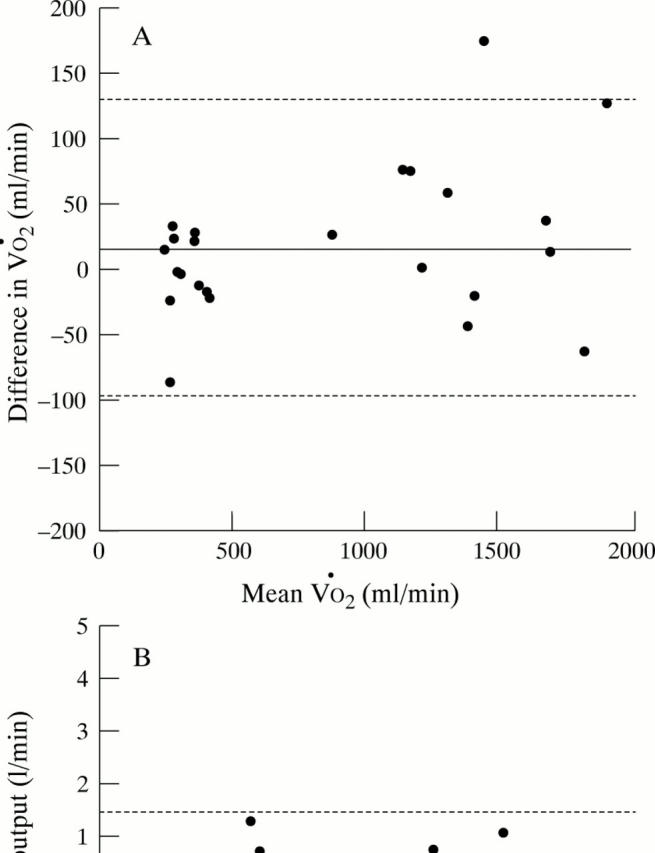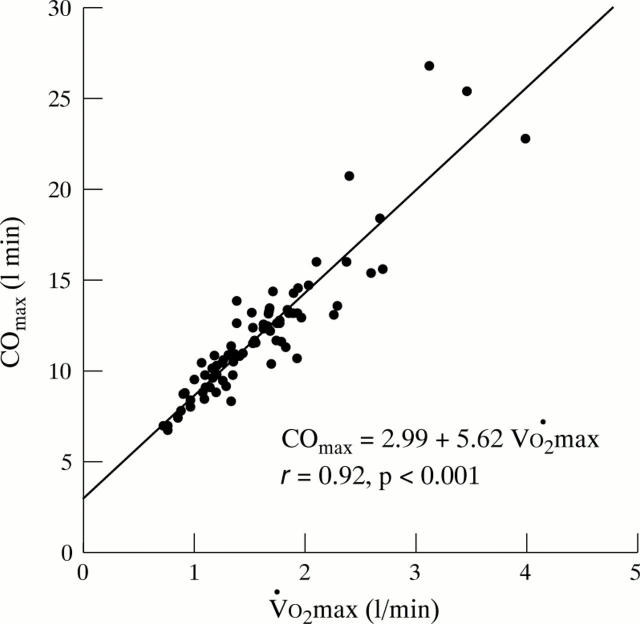Abstract
Objective—To investigate whether physiological cardiac reserve can be measured in man without invasive procedures and whether it is a major determinant of exercise capacity. Design—Development of method of measurement and an observational study. Setting—A regional cardiothoracic centre. Subjects—70 subjects with a wide range of cardiac function, from heart failure patients to athletes. Methods—Subjects underwent treadmill, symptom limited cardiopulmonary exercise tests to measure aerobic exercise capacity (represented by V̇O2max) and cardiac reserve. Cardiac output was measured non-invasively using the CO2 rebreathing technique. Results—Cardiac power output (CPOmax) at peak exercise was found to be significantly related to aerobic capacity: CPOmax (W) = 0.35 + 1.5V̇O2max (l/min), r = 0.87, p < 0.001. It also correlated well with exercise duration (r = 0.62, p < 0.001), suggesting that cardiac reserve is a major determinant of exercise capacity. In the study, cardiac reserve ranged from 0.27 to 5.65 W, indicating a 20-fold difference between the most impaired cardiac function and that of the fittest subject. Conclusions—A non-invasive method of estimating physiological cardiac reserve was developed. The reserve was found to be a major determinant of exercise capacity in a population of normal subjects and patients with heart disease. This method may thus be used to provide a clearer definition of the extent of cardiac impairment in patients with heart failure. Keywords: cardiac reserve; cardiac power output; oxygen consumption; congestive heart failure
Full Text
The Full Text of this article is available as a PDF (126.3 KB).
Figure 1 .
A plot of cardiac output during peak exercise (COmax) against an indicator of aerobic exercise capacity, V̇O2max (peak oxygen consumption).
Figure 2 .
A plot of cardiac power output during peak exercise (CPOmax) against aerobic exercise capacity, V̇O2max.
Figure 3 .

Bland and Altman plots18,19 of the differences against the means of repeated measurements of (A) maximum oxygen consumption (V̇O2max), (B) cardiac output (COmax), and (C) cardiac power output (CPOmax) during peak exercise, to indicate reproducibility of measurements (means and ± 2 SD limits indicated). See text for details.
Selected References
These references are in PubMed. This may not be the complete list of references from this article.
- ASTRAND P. O., CUDDY T. E., SALTIN B., STENBERG J. CARDIAC OUTPUT DURING SUBMAXIMAL AND MAXIMAL WORK. J Appl Physiol. 1964 Mar;19:268–274. doi: 10.1152/jappl.1964.19.2.268. [DOI] [PubMed] [Google Scholar]
- Astrand P. O. Quantification of exercise capability and evaluation of physical capacity in man. Prog Cardiovasc Dis. 1976 Jul-Aug;19(1):51–67. doi: 10.1016/0033-0620(76)90008-6. [DOI] [PubMed] [Google Scholar]
- Beaver W. L., Wasserman K., Whipp B. J. A new method for detecting anaerobic threshold by gas exchange. J Appl Physiol (1985) 1986 Jun;60(6):2020–2027. doi: 10.1152/jappl.1986.60.6.2020. [DOI] [PubMed] [Google Scholar]
- Benge W., Litchfield R. L., Marcus M. L. Exercise capacity in patients with severe left ventricular dysfunction. Circulation. 1980 May;61(5):955–959. doi: 10.1161/01.cir.61.5.955. [DOI] [PubMed] [Google Scholar]
- Bland J. M., Altman D. G. Statistical methods for assessing agreement between two methods of clinical measurement. Lancet. 1986 Feb 8;1(8476):307–310. [PubMed] [Google Scholar]
- COLLIER C. R. Determination of mixed venous CO2 tensions by rebreathing. J Appl Physiol. 1956 Jul;9(1):25–29. doi: 10.1152/jappl.1956.9.1.25. [DOI] [PubMed] [Google Scholar]
- DEFARES J. G. Determination of PvCO2 from the exponential CO2 rise during rebreathing. J Appl Physiol. 1958 Sep;13(2):159–164. doi: 10.1152/jappl.1958.13.2.159. [DOI] [PubMed] [Google Scholar]
- Faulkner J. A., Heigenhauser G. J., Schork M. A. The cardiac output--oxygen uptake relationship of men during graded bicycle ergometry. Med Sci Sports. 1977 Fall;9(3):148–154. [PubMed] [Google Scholar]
- Franciosa J. A., Leddy C. L., Wilen M., Schwartz D. E. Relation between hemodynamic and ventilatory responses in determining exercise capacity in severe congestive heart failure. Am J Cardiol. 1984 Jan 1;53(1):127–134. doi: 10.1016/0002-9149(84)90696-9. [DOI] [PubMed] [Google Scholar]
- Franciosa J. A., Park M., Levine T. B. Lack of correlation between exercise capacity and indexes of resting left ventricular performance in heart failure. Am J Cardiol. 1981 Jan;47(1):33–39. doi: 10.1016/0002-9149(81)90286-1. [DOI] [PubMed] [Google Scholar]
- Jacobi M. S., Iyawe V. I., Patil C. P., Cummin A. R., Saunders K. B. Ventilatory responses to inhaled carbon dioxide at rest and during exercise in man. Clin Sci (Lond) 1987 Aug;73(2):177–182. doi: 10.1042/cs0730177. [DOI] [PubMed] [Google Scholar]
- Massie B. M., Kramer B., Haughom F. Acute and long-term effects of vasodilator therapy on resting and exercise hemodynamics and exercise tolerance. Circulation. 1981 Dec;64(6):1218–1226. doi: 10.1161/01.cir.64.6.1218. [DOI] [PubMed] [Google Scholar]
- McHardy G. J. The relationship between the differences in pressure and content of carbon dioxide in arterial and venous blood. Clin Sci. 1967 Apr;32(2):299–309. [PubMed] [Google Scholar]
- Nugent A. M., McParland J., McEneaney D. J., Steele I., Campbell N. P., Stanford C. F., Nicholls D. P. Non-invasive measurement of cardiac output by a carbon dioxide rebreathing method at rest and during exercise. Eur Heart J. 1994 Mar;15(3):361–368. doi: 10.1093/oxfordjournals.eurheartj.a060504. [DOI] [PubMed] [Google Scholar]
- Tan L. B. Cardiac pumping capability and prognosis in heart failure. Lancet. 1986 Dec 13;2(8520):1360–1363. doi: 10.1016/s0140-6736(86)92006-4. [DOI] [PubMed] [Google Scholar]
- Tan L. B. Clinical and research implications of new concepts in the assessment of cardiac pumping performance in heart failure. Cardiovasc Res. 1987 Aug;21(8):615–622. doi: 10.1093/cvr/21.8.615. [DOI] [PubMed] [Google Scholar]
- Tan L. B., Littler W. A. Measurement of cardiac reserve in cardiogenic shock: implications for prognosis and management. Br Heart J. 1990 Aug;64(2):121–128. doi: 10.1136/hrt.64.2.121. [DOI] [PMC free article] [PubMed] [Google Scholar]




